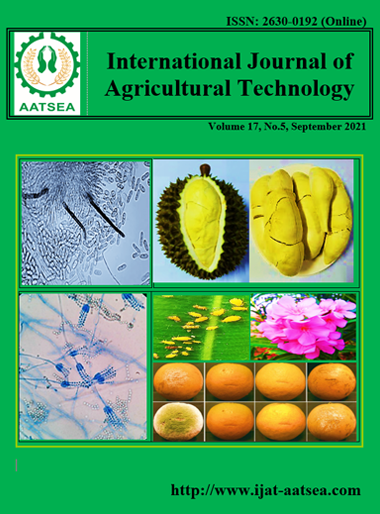The effects of Lactobacillus plantarum inoculation of spontaneously fermented cassava pulp (SFCP) on the quality, feed intake and growth of Lao-native beef steers
Main Article Content
Abstract
The inoculated with Lactobacillus plantarum at concentration of 1.0 x 105 CFU/g FM showed the diet’s protein contents of 14.39% DM, while the uninoculated was 13.30% DM. The pH values of the uninoculated spontaneously fermented cassava pulp (SFCP) were higher than the inoculated cassava pulp (P<0.01), while the pH of the fermented total mixed ration (FTMR) was not affected by inoculant addition (P>0.05). Total feed intakes were not significantly different between the treatments except during 60 days of the experiment, which showed that the feed intake of uninoculated FTMR was higher than the inoculated FTMR (P<0.01). Overall, ruminal pH, NH3-N, and BUN were not affected by diet. However, steers were fed FTMR inoculated with L. plantarum, which significant affected on ADG and FCR compared to the control during 60 days after feeding period. The study indicated that SFCP inoculation with L. plantarum can improve the quality of the SFCP in the laboratory, whereas inoculated FTMR with L. plantarum was not decreased pH value. Finally, steers fed FTMR with inoculation had shown more significant ADG and FCR at 60 days after feeding
Article Details

This work is licensed under a Creative Commons Attribution-NonCommercial-NoDerivatives 4.0 International License.
References
AOAC (1990) Official Methods of Analysis. 15th Edition, Association of Official Analytical Chemist, Washington DC, pp. 69-80.
Cai, Y., Benno, Y., Ogawa, M. and Kumai, S. (1999). Effect of applying lactic acid bacteria isolated from forage crops on fermentation characteristics and aerobic deterioration of silage. Journal of Dairy Science, 82:520-526.
Cao, Y., Takahashi, T., Horiguchi, K. and Yoshida, N. (2010). Effect of adding lactic acid bacteria and molasses on fermentation quality and in vitro ruminal digestion of total mixed ration silage prepared with whole crop rice. Grassland Science, 56:19-25.
FAOSTAT (2020). Live Animal in Lao PDR. Food and Agriculture Organization of the United Nations. Retrived from http://www.fao.org/faostat/en/#data/QA.
Goering, H. K. and Van Soest, P. J. (1970). Forage fiber analysis (apparatus, reagent, procedures and some application). Agric. Handbook No. 379. ARS, USDA, Washington, D.C.: USA. pp.8-9.
Kamphayae, S., Kumagai, H., Bureenok, S., Narmseelee, R. and Butcha, P. (2016). Effects of graded levels of liquid brewer’s yeast on chemical composition and fermentation quality in cassava pulp and rice straw-based total mixed ration silage. Animal Science Journal, 88:618-624.
Kang-Meznarich, J. H. and Broderick, G. A. (1980). Effects of incremental urea supplementation on ruminal ammonia concentration and bacterial protein formation. Journal of Animal Science, 51:422-431.
Lao Statistics Bureau (2020). Population 1985-2019. Retrived from https://www.lsb.gov.la/en/home/.
Nampanya, S., Khounsy, S., Rast, L., Young, J. R., Bush, R. D. and Windsor, P. A. (2013). Progressing smallholder large-ruminant productivity to reduce rural poverty and address food security in upland northern Lao PDR. Animal Production Science, 54:899-907.
Napasirth, P. and Napasirth, V. (2018). Current situation and future prospects for beef production in Lao People’s Democratic Republic — A review. Asian-Australasian Journal of Animal Sciences, 31: 961-967.
Napasirth, V., Napasirth, P., Sulinthone, T., Phommachanh, K. and Cai, Y. (2015). Microbial population, chemical composition and silage fermentation of cassava residues. Animal Science Journal, 86:842-848.
National Research Council (2000). Nutrient requirements of cattle. 7th ed. Washington, DC: National Academy Press. pp.22-33.
Pilajun, R. and Wanapat, M. (2016). Chemical composition and in vitro gas production of fermented cassava pulp with different types of supplements. Journal of Applied Animal Research, 46:81-86.
Ryser, E. T., Arimi, S. M. and Donnelly, C. W. (1997). Effects of pH on distribution of Listeria ribotypes in corn, hay, and grass silage. Applied and Environmental Microbiology, 63:3695-3697.
Saengchan, K., Nopharatana, M., Lerdlattaporn, R. and Songkasiri, W. (2015). Enhancement of starch-pulp separation in centrifugal-filtration process: Effects of particle size and variety of cassava root on free starch granule separation. Food and Bioproducts Processing, 95:208-217.
Sriroth, K., Chollakup, R., Chotineeranat, S., Piyachomkwan, K. and Oates, C. G. (2000). Processing of cassava waste for improved biomass utilization. Bioresource Technology, 71:63-69.
Vongsamphanh, P., Napasirth, V., Inthapanya, S. and Preston, T. R. (2014). Cassava pulp as livestock feed; effects of storage in an open pit. Livestock Research for Rural Development. Retrieved from http://www.lrrd.org/lrrd26/9/phan26169.htm.
Yahaya, M., Kawai, M., Takahashi, J. and Matsuoka, S. (2002). The effect of different moisture contents at ensiling on silo degradation and digestibility of structural carbohydrates of orchardgrass. Animal Feed Science and Technology, 101:127-33.


